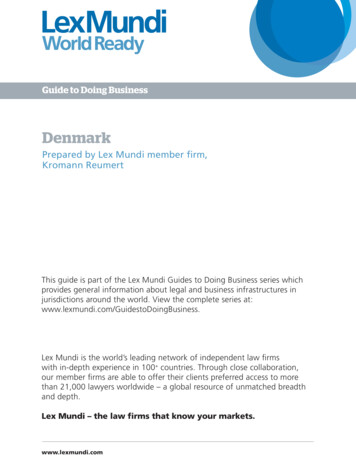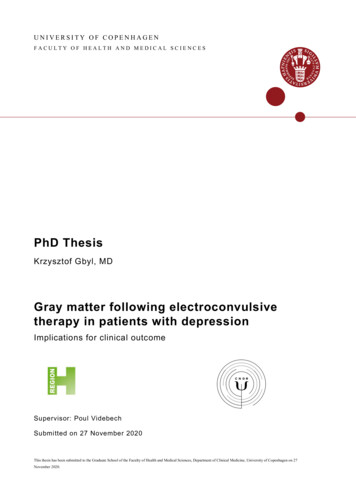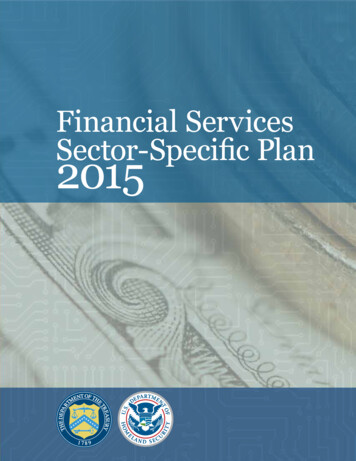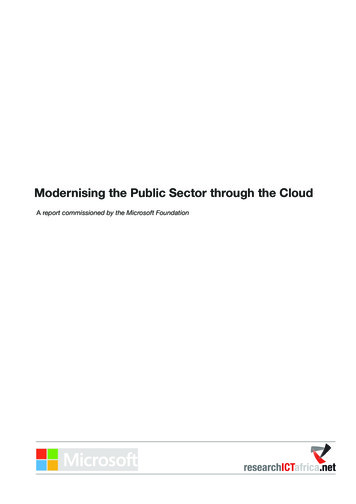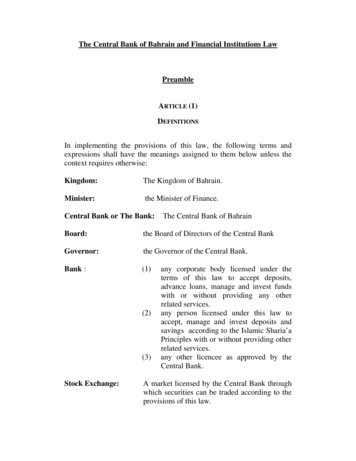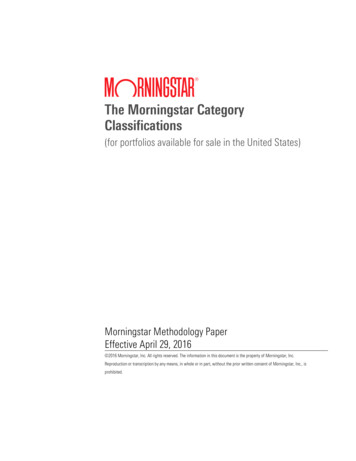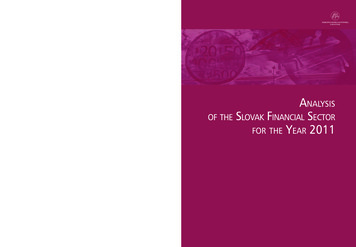
Transcription
2007 International Monetary FundMarch 2007IMF Country Report No. 07/123Denmark: Financial Sector Assessment Program—Technical Note—The Danish Mortgage Market—A Comparative AnalysisThis Technical Note on The Danish Mortgage Market—A Comparative Analysis, was prepared by astaff team of the International Monetary Fund as background documentation to the Financial SectorAssessment Program with the member country. It is based on the information available at the time itwas completed in September 2006. The views expressed in this document are those of the staff teamand do not necessarily reflect the views of the government of Denmark or the Executive Board of theIMF.The policy of publication of staff reports and other documents by the IMF allows for the deletion ofmarket-sensitive information.To assist the IMF in evaluating the publication policy, reader comments are invited and may besent by e-mail to publicationpolicy@imf.org.Copies of this report are available to the public fromInternational Monetary Fund Publication Services700 19th Street, N.W. Washington, D.C. 20431Telephone: (202) 623 7430 Telefax: (202) 623 7201E-mail: publications@imf.org Internet: http://www.imf.orgPrice: 18.00 a copyInternational Monetary FundWashington, D.C.
FINANCIAL SECTOR ASSESSMENT PROGRAMDENMARKTECHNICAL NOTETHE DANISH MORTGAGE MARKET:A COMPARATIVE ANALYSISSEPTEMBER 2006INTERNATIONAL MONETARY FUNDMONETARY AND FINANCIAL SYSTEMS DEPARTMENT
2ContentsPageI. Introduction .3II. The Danish mortgage system: Regulatory Framework.3A. Mortgage Credit Institutions are Specialized Lenders.3B. The Balance Principle .5C. Strict Lending Rules.6D. Registration and Foreclosure .7E. The Supervision of Mortgage Banks.8III. Mortgage Financing In Denmark.8A. The Product Side: Mortgage Loans .8B. The funding Side: The Danish Mortgage Bond Market.12C. Danish Mortgage Bonds and Evolution of the European Covered Bond Market.13IV. Concluding Remarks .20References.21Tables1. Concentration in EU Mortgage Markets.42. Availability of Mortgage Products.113. Main Features of Danish Mortgage Bonds .124. Covered Bonds: Market share of the Main Countries of Issuance .145. Main Features of Covered Bonds, Danish Mortgage Bonds and Mortgage-Backed.156. Covered Bond Legislation in Selected European Countries.177. Risk-Weighting of Covered Bonds under the Capital Requirement Directive.19Figures1. The Balance Principle .52. Investors in Danish Mortgage Bonds (Q1 2005) .13Boxes1. Bond Loans and Cash Loan .102: Covered bonds in EU Regulation .18
3I. INTRODUCTION1.The Danish mortgage system is among the most sophisticated housing financemarkets in the world and presents some unique characteristics. The combination of atight regulatory framework with developed specialized, “in-house” expertise in lending andcredit assessment, and in wholesale funding and risk management has translated into a highlyrated system (and institutions), able to deliver a variety of mortgage products at close tocapital market conditions. The note will (i) discuss the particularities of the regulatoryframework of the Danish mortgage system. It will then (ii) compare and contrast mortgagefinancing in Denmark and in other European countries, looking both at the product side (i.e.,mortgage loans) and at the funding side (i.e., mortgage bonds) and discuss recent Europeanregulatory evolutions, which could have potentially far-reaching consequences for the Danishmortgage system. To conclude, the paper will (iii) highlight the challenges faced by theDanish mortgage system.II. THE DANISH MORTGAGE SYSTEM: REGULATORY FRAMEWORK2.The Danish mortgage system is widely recognized as one of the mostsophisticated housing finance systems in the world. Through the implementation of a strictbalance principle, the system has proved very effective in providing borrowers with flexible,transparent and close-to-capital markets funding conditions. Simultaneously, as pass-throughsecurities, mortgage bonds transfer market risk from the issuing mortgage bank to bondinvestors. Lastly, strict property appraisal rules and credit risk management by the mortgagebanks have also historically shielded mortgage bonds from default risk.A. Mortgage Credit Institutions are Specialized Lenders3.Mortgage Credit Institutions (MCIs) are specialized lenders restricted toconducting narrowly defined mortgage credit activities. Mortgage credit institutions arethe only financial institutions allowed to grant loans against mortgage on real property byissuing mortgage bonds (Realkreditobligationer). The scope of activities allowed to MCIs islimited to the origination and servicing of mortgage loans, their funding, exclusively throughthe issuance of mortgage bonds, and activities deemed accessory. They are not authorized tofund their credit activity with deposits or issue guarantees, but can develop banking andinsurance activities through subsidiaries.4.The Danish mortgage system is highly concentrated and comprises mutualassociations and public limited companies. The Danish mortgage system was firstestablished as a cooperative or mutual system, at the end of the 18th century, essentially toserve local communities.1 The first Danish Mortgage Act was passed in 1850, establishing1Loans against mortgages on real property were initially provided on the basis of a joint and several liability ofborrowers: each and every mortgage borrower in a pool was severally and jointly liable for the liabilities of theentire bond series backing the pool. Several and joint liability started to decline in 2001, and the majority ofmortgage bonds is now issued without the several and joint liability of borrowers.
4new mortgage credit institutions, as associations. The system kept evolving thereafter, inparticular in the early 1970s, when mortgage financing was simplified and standardized. Thelast major round of reform took place in 1989, removing existing restrictions to theestablishment of new mortgage credit institutions, as public limited companies, andauthorizing commercial banks to own mortgage credit institutions. Today, there are eightmortgage credit institutions active in the Danish mortgage market, some affiliated withcommercial banks (DLR, LR, Nordea Kredit, RealKredit Danmark, FIH), others operating ona standalone basis, as foundations (BRFKredit, NykreditRealkredit). While some institutionsspecialize in specific market segments, others cater for the entire spectrum of mortgageborrowers.2 The specialized lender principle and the progressive rationalization of the systemexplain that the high degree of concentration of the Danish mortgage market is quite uniquein Europe, only matched by the Swedish market (Table 1).Table 1. Concentration in EU Mortgage and Housing Credit SpainSwedenUKCzech. RepublicHungaryPolandMarket Share of the Five BiggestLenders, in Percent (2003)95375456575509560807080Sources: ECB (2004); and Mercer Oliver Wyman (2003) in LondonEconomics (2005)5.Access to distribution channels is critical and is likely to be increasinglyimportant. Mortgage credit institutions compete in a tightly regulated environment. Thespecialized nature of mortgage institutions and the largely commoditized nature of mortgageproducts in Denmark result in competition for market share primarily taking place throughproduct innovation and distribution, and distribution channels are likely to be increasinglyimportant going forward. Mortgage credit institutions often do not have their owndistribution networks but offer their products through a large range of distribution channels,including branch networks of commercial banks (note that most of the largest mortgagecredit institutions are part of banking groups) and agreements with realtors.23For example, DLR Kredit focuses primarily on agriculture properties and private home rental.Following the acquisition of Totalkredit by Nykredit in 2004, the five biggest lenders represent more than 99percent of mortgage lending in Denmark.
5B. The Balance Principle6.As a result of a strict interpretation of the balance principle established by theMortgage Credit Act, the Danish mortgage system is a pass-through system allowingmortgage borrowers to benefit from close to capital market financing conditions. Thebalance principle imposes strict matching rules between the assets (e.g., mortgage loans) andthe liabilities (e.g., mortgage bonds) of mortgage credit institutions. Each new loan is inprinciple funded by the issuance of new mortgage bonds of equal size and identical cash flowand maturity characteristics. The proceeds from the sale of the bonds are passed to theborrower and similarly, interest and principal payments are passed directly to investorsholding mortgage bonds (Figure 1).Figure 1. The Balance PrincipleBorrowerMortgage Credit nt / feesMortgage LoansBondInvestorLiabilitiesMortgage BondsCash Flows-Balance PrincipleInterest rate matchingDuration/liquidity matchingCurrency matching7.The prepayment of mortgage loans results in a proportionate redemption ofmortgage bonds, and remortgaging results in the issuance in new bonds. Withinmortgage credit institutions, mortgage pools and the corresponding bonds can be segregatedin different “capital centers,” each with its own reserve fund, and ring-fenced from the rest ofthe institution. By essentially limiting the role of mortgage credit institutions to conduitsbetween mortgage borrowers and mortgage bond investors, the system allow the former tobenefit from financing conditions directly derived from those that prevail in capital markets,for the type of loan they request, at the time the borrowing takes place. The service providedby the mortgage institution is paid for by borrowers through front-end fees, annualadministrative fees, and pre-payment fees. The annual contribution paid by borrowersdepends on the level of the Loan To Value ratio at the time when the bonds are issued. Itcovers the interest margin of the mortgage credit institution, and usually represents 0.5percent of the remaining debt.8.The evolution from a full to a new “global” balance principle has given mortgagecredit institution some limited flexibility in the management of their assets andliabilities. Before 2000, MCIs were required to implement a perfect match between theirassets and their liabilities with respect to interest rate and maturity characteristics. The 2000
6amendments to the Mortgage Credit Act relaxed the strict matching requirements imposed onindividual loans and bonds, and introduced instead specific requirements on aggregate risks(i.e., interest rate, liquidity, exchange rate and counterparty risks), therefore allowing forenhanced product innovation while maintaining tight asset and liability managementconstraints. For example, while mortgage bonds must be secured on loans granted againstmortgages on real property, up to 2 percent of a bond series can be collateralized by safesubstitute assets, such as government bonds, in order to facilitate the management ofredemption risk. However, interest rate risk arising from mismatches between assets andliabilities cannot represent more than 1 percent of the capital base of the institution.4Liquidity gaps, measured as the net present value of cash flows related to loans and fundingare limited to a declining proportion of the capital base as the payment date nears: liquiditydeficits for payments expected in more than 10 years can represent up to 100 percent of thecapital base of the institution. They can not exceed 50 percent when due between year 4 andyear 10, and are limited to 25 percent for payments due between year 1 and year 3. WhileMCIs are allowed to use options to manage their assets and liabilities, they are normallylimited to options with a maturity of four years or less. Lastly, mortgage credit institutionsare not allowed to carry exchange rate risk in excess of 0.1 percent of their capital base.59.Strict rules also apply to the management of their capital base by mortgagecredit institutions. For MCIs, capital adequacy requirements apply not only at the level ofthe institution as a whole, but also at the level of each and every capital center within theinstitution. At least 60 percent of the capital base (and reserves) must be invested in listedbonds, and the associated interest rate risk, measured as a 100 bp adjustment must not exceed8 percent of the capital base. Mortgage credit institutions are also limited in their ability toinvest their capital. For example, real estate assets and property companies cannot representmore than 20 percent of their capital base.10.In the conduct of their activities, the risk assumed by mortgage creditinstitutions is largely limited to credit risk. This risk has two components: the risk that theborrower defaults and, in this context, the risk that the value of the property will not matchthe outstanding amount of the loan. Note that new types of mortgage loans are changing theway credit risk is incurred by mortgage banks: with deferred amortization loans, credit risk ishigher, since repayments are postponed to a future date.C. Strict Lending Rules11.The strict lending rules imposed by the Mortgage Credit Act differ depending onthe type of property financed. Maximum loan to value (LTV) ratios and lending periods areset up for each category of property. While for all categories of properties, the maximumlending period can be up to 30 years (and up to 35 years cooperative homes), maximum45Interest rate risk is calculated as the worst-case outcome from a series of scenarios specified by the supervisor.Exchange rate risk is measured on a VaR basis: maximum loss over a 10 day period, at a 99 percentprobability, for all relevant on balance sheet, including the securities portfolio, and off balance sheet items.
7lending limits differ significantly according to the nature of the mortgaged property. Forowner-occupied homes, rental properties, cooperative homes and housing projects, mortgageloans can represent up to 80 percent of the value of the property. In contrast, maximum LTVratios are limited to 70 percent for agricultural properties, 60 percent for commercial realestate and secondary residences, and 40 percent for un-built sites.6 In addition, a change inthe purpose of a mortgaged property and the transfer of a property to another propertycategory can result in changes in the characteristics of the mortgage loan.12.In assessing the “mortgageable” value of properties, mortgage credit institutionsare expected to adopt a conservative approach. The key principle is that the estimatedvalue should fall within the amount that an experienced buyer with knowledge about priceand market conditions for the said type of property would be deemed to be willing to pay. Inparticular, when assessing the market value of the property, the risks of changes in marketconditions as well as in the structural conditions of the property shall be taken into accountwhereas factors which result in a particularly high price shall be discarded. The propertyserving as collateral must be valued on sight. However, following this initial assessment,mortgage lenders are not required to periodically mark-to-market the value of the propertiesbacking their loans.D. Registration and Foreclosure13.Effective land and mortgage registration are key elements contributing to thegood functioning of the Danish mortgage system. Denmark maintains three registers ofreal properties. The cadastre (Kort-og Matrikelstyrelsen) is the basic register, and gives aspecific identification number to each land parcel. This unique title number is then used byother registers, in particular the Land Book. The Land Book registers all rights attached toeach property, and is therefore the legal register providing safe titles and securing privaterights. It is only when a mortgage has been finally and correctly registered in the Land Bookthat the mortgage bank can grant a loan without any other type of security. The Land Book isadministered by district courts, under the responsibility of the Ministry of Justice. Lastly, theMunicipal Register of Real Properties gathers data on valuation of land parcels and buildings,and is mainly used in relation with the collection of land taxes.14.Speedy forced sales and repossession procedures add to the efficiency of thisframework. In the event of non-payment of its mortgage-related obligations by themortgagor, the mortgage bank may put the property up for a forced sale. Forced sales arecarried through by enforcement courts, which are part of the ordinary system of courts.Mortgagees will be covered in order of priority and while uncovered mortgage loans will bedeleted from the Land Register, but the mortgagees will keep their (uncovered) claim againstthe borrower as a personal claim. It typically takes no more than six months from the timewhen the borrower defaults on the loan until a forced sale can be carried through.6As the Danish corporate structure is dominated by SMEs that do not have access to the corporate bond market,mortgage loans are frequently used by the corporate sector to finance its activities.
8E. The Supervision of Mortgage Banks15.The supervision of mortgage credit institutions by the Danish FSA combines thegeneral risk-based approach used for all banking institutions with a specific focus onthe framework set up by the Mortgage Credit Act. In the evaluation of a financialinstitution, the DFSA distinguishes between the general risk inherent with the type ofinstitution and the specific risk associated to a particular institution. In contrast tocommercial banks, which are assumed to have a “high general risk,” MCIs are considered as“average general risk” institutions, thanks to the various legal and regulatory limitationsplaced on the risks they are allowed to assume. The specific risk of each institution isestimated by the supervisor’s internal rating system. Through ratios related to solvency,growth in loan portfolios, evolution of market risks, the rating system helps determine theintensity of supervision applied to each individual institution. Regarding mortgage creditinstitutions, indicators based on the issuance of mortgage bonds and the origination of loanshelp assess how institutions implement the requirements of the balance principle. Theanalysis of loans granted by type of properties and comparative reports on late payments andlosses allow to closely monitoring the evolution of credit risk within the different mortgagecredit institutions. Specific on-site inspection programs focusing on key aspects such asproperty valuation practices complement the off-site supervisory work.7III. MORTGAGE FINANCING IN DENMARK16.The balance principle and the tight regulatory framework in which mortgage creditinstitutions operate have not prevented the broadening of the range of mortgage loansavailable to borrowers, and the corresponding diversification of mortgage bonds available toinvestors.A. The Product Side: Mortgage Loans17.Fixed rate callable annuity loans remain the dominant mortgage loans, althoughnew type of loans has appeared since the mid-90s, in response to the changing demandexpressed by borrowers and mortgage bond investors. Adjustable interest rate loans havebeen reintroduced in 1996, with maturity up to 30 years. The associated mortgage bonds havea shorter maturity than the corresponding loans. The entire remaining debt, or a specificfraction of it, is refinanced at periodic intervals.8 At the time of the refinancing, the intereston the loan is adjusted to the market level. Adjustable interest loans can also be granted in aseries of installments, over a specified number of years. Loans with an installment free periodof up to 10 years (interest-only loans) have been introduced in 2003, as adjustable interestloans or fixed rate loans. Mortgage loans with interest rate guarantees were introduced in78The DFSA uses its own valuator teams.Noncallable bullet bonds with maturity from 1 to 11 years are used to finance interest reset loans: theborrower takes out a 20- to 30-year annuity loan, where interest rate is adjusted periodically (typically yearly).When the remaining debt of the loan needs to be refinanced, new bonds are issued.
92004, in two main forms: (i) floating-to-fixed loans, where the conversion takes place whenthe 6-month CIBOR rate reach the cap, and then remain fixed even if the market rate laterdeclines; and (ii) capped-floater loans, where the interest rate is reduced if the rate laterdeclines again, and combine a fixed-interest rate loan with interest reset features and arebased on variable interest bonds, adjusted over CIBOR every 6 months. The maturity of theunderlying bonds ranges from 5 to 30 years, and the entire loan is refinanced when the bondmatures. Thanks to the balance principle, these new type of loans do not result in additionallarge funding or liquidity risk for the mortgage banks. However, some of these loans(interest-only loans) may prove more risky for borrowers, and this may further strain therepayment ability of residential as well as corporate borrowers, potentially contributing to amore general increase in non-performing loans when the credit cycle deteriorates.18.The growing appetite of Danish mortgage borrowers for variable rate loans inrecent years is not unique, but corresponds to a trend witnessed throughout Europe(and in the US). A survey study conducted by London Economics (2005) showed thatmortgage loans with interest rate fixation periods of less than a year have gained ground inmost European countries, where mortgage loans are traditionally fixed-rate loans in recentyears. In Denmark in particular, the estimated market share of mortgage loans with interestrate fixation periods of less than a year (including capped loans) grew from 4.2 percent toabout 37 percent between 1999 and Q2 2006. More precisely, their share of the mortgagemarket has remained stable or declined only in countries where variable rate loans are usuallythe dominant form of mortgage loans. In the UK, their market share declined from 80.5percent to 75 percent.19.A distinctive feature of the Danish mortgage market is the call and deliveryoption embedded in standard Danish mortgage loans. These embedded call and deliveryoptions enable a borrower to pre-pay or buy-back his loan at any given time, at par or at theprevailing market price. Outside of Denmark, only U.S. fixed-rate mortgage contracts offerborrowers a penalty-free (i.e., other than administrative fees) prepayment option (but nodelivery option). Fixed-rate mortgage loans can be granted as callable or non-callable loans.Callable loans may be prepaid, at par, before maturity, either on a payment date or “at once”(i.e., before the next payment debt).9 Adjustable interest rate loans (and index-linked loans)are always non-callable, and can only be redeemed at par at the time of the adjustment. Likeother mortgage loans, they can, however, be prepaid at any time, by delivering the underlyingbonds. In a high interest rate environment, the borrower can cancel his loan by buying backequivalent bonds in the market, instead of being forced to prepay and incur a loss.Furthermore, when rates are high, buying back the loan (below par) and refinancing intoanother loan/bond closer to par allows for capital gains, in return for accepting larger coupon9Since bond investors are entitled to their coupon payments until the next payment date, the borrower will haveto prepay the full coupon. He will, however, be compensated for making the funds available to the creditinstitution before the payment date, at a rate close to the prevailing money market rate.
10payments. Practically, the mortgagor buys back “his” bonds in the market and delivers themto the mortgage credit bank that will then cancel the loan.10Box 1. Bond Loans and Cash LoansMortgage loans can be granted as bond loans or cash loans. In a bond loan, the principal of the loan matches thevolume of bonds that are issued by the mortgage credit institution. The amount paid to the borrower correspondsto the market value of the issued bonds. If the bond price is below par (or if interest rate rise between the momentthe loan is offered and the time it is paid to the borrower) then a higher number of bonds must be sold, and theprincipal of the loan will exceed the proceeds effectively paid to the borrower. The interest rate on the loan isequal to the coupon rate on the underlying bonds. In a cash loan, the principal of the loan corresponds to theproceeds effectively paid out to the borrower. The face value of the loan corresponds to the market value of theunderlying bonds. The interest rate on the loan corresponds to the yield to maturity of the underlying bonds, andis higher than to the coupon rate of the bonds, since the bonds are usually issued below par. Compared to bondloans, the non-deductible capital loss is transformed into higher, tax deductible, interest payments. In return,prepayment of cash loans will lead to the taxation of investment gains. Fixed Price Agreements and guaranteesallow the borrower to hedge the uncertainty associated with bond and cash loans.20.These options and the increased variety of mortgage loans have contributed toan increase in re-mortgaging activity in the recent period of declining long-term interestrates. In periods of falling interest rates, remortgaging into a new loan with a lower nominalinterest rate will result in a gain in the form of lower future net payments; usually, however,at the price of an increase in the overall outstanding debt. Conversely, at time of rising longterm interest rates, redeeming an existing loan at a lower market price and refinancing into anew loan will achieve a reduction in outstanding debt, at the price of higher future interestpayments. The strategy is ultimately profitable if the interest rate declines again in a not toodistant future, allowing for another remortgaging operation to a lower coupon debt.11 Theintroduction of adjustable interest rate loans has expanded the range of remortgagingstrategies. In a steepening yield curve environment and rising long-term rates, borrowersholding a fixed-rate callable mortgage loan can refinance into shorter variable rate mortgageloans and reduce their outstanding debt. Conversely, in a flattening environment withdeclining long-term rates, holders of variable rate mortgage loans will be inclined torefinance into long-term fixed mortgages. Increased sophistication of advisory services atmortgage credit institutions have led to more systematic monitoring of remortgagingopportunities for their customers, and contributed to fuel remortgaging activity in recent10For bond investors the call and delivery options embedded in Danish mortgage bonds impose a pre-paymentrisk throughout the maturity of the bonds. For different bond series, the prepayment risk is influenced by thetrend and volatility of interest rate and the composition of the underlying borrowers’ pool. Changes in theprobability of prepayment can quickly affect the liquidity of mortgage bond series. With the development ofnew types of loans, the complexity of the option features imbedded in mortgage bonds increases, requiringincreasingly sophisticated risk management systems.11Before the tax deductibility of interest rate payments was reduced in 1998, “horizontal remortgaging”allowed borrowers with fixed rate cash loans to benefit from rising interest rates, by refinancing through a newcash loan backed by bonds carrying the same nominal coupon as the old loans, but a higher effective interestrate, therefore leading to lower future net interest payments.
11years. However, products such as capped loans are likely to lead, ultimately, to a decline inremortgaging over the longer term.21.Compared to other European housing finance systems, the Danish mortgagesystem combines a relatively high degree of completeness and cost-efficiency. Marketcompleteness can be evaluated against a series of criteria, in particular the variety of mortgageproducts available to potential borrowers, market access (i.e., the range of borrowers whoeffectively have access to mortg
The Danish mortgage system is highly concentrated and comprises mutual associations and public limited companies. The Danish mortgage system was first established as a cooperative or mutual system, at the end of the 18th century, essentially to serve local communities.1 The first Danish Mortgage Act was passed in 1850, establishing

